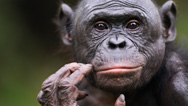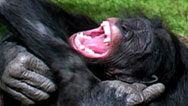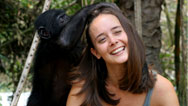Profile: Laurie Santos
- Posted 11.07.12
- NOVA scienceNOW
On the island of Cayo Santiago, off the coast of Puerto Rico, Yale scientist Laurie Santos is studying a unique community of rhesus macaques. More than 900 monkeys freely roam the island, and their society—complete with insiders and outsiders, Queen Bees and wannabes—is eerily similar to our human society.
Transcript
What Are Animals Thinking?
PBS Airdate: November 7, 2012
DAVID POGUE: Off the coast of Puerto Rico, there's an isolated island kingdom ruled by our distant relatives, very distant. On Cayo Santiago, rhesus monkeys reign, but today, they're getting some visitors: Laurie Santos and her team of researchers.
The Yale cognitive psychologist has made a career out of studying monkeys. And while she spends most of her time on campus and in the classroom—where she recently won a top teaching award—her favorite place is Cayo.
LAURIE SANTOS (Yale University): For me, I have this moment of just feeling completely at home. It's like, "My monkeys!.
That guy is checking me out.
DAVID POGUE: Laurie wants to know what monkeys are thinking. And monkeys on Cayo Santiago are the perfect subjects. They were brought from Asia in the 1930s to populate the island for behavioral research. Originally, there were only 400. Today, more than a thousand live here.
LAURIE SANTOS: It's this fabulous site for research. We know who's related to who. We know all the information about where males were born. We can get these big populations and really see variation in how the individuals interact and what they know about the world.
DAVID POGUE: Before Laurie could understand their thoughts, she had to understand how things work on the island.
LAURIE SANTOS: Here's Josh, my buddy.
Come get some food, boy.
It's just like seeing old friends: "Oh, look at you," you know, "you grew up so well." "Oh, you've a kid now. That's great..
DAVID POGUE: She has come to understand their monkey society, complete with insiders, outsiders, queen bees and wannabes.
LAURIE SANTOS: There are six different social groups on the island. The groups can sometimes have tensions.
DAVID POGUE: The alpha group rules the island, and its members get first dibs at whatever they want, including the monkey chow humans feed them. They show their status at the feeding troughs. Beta groups hang back until the alpha group has had its fill.
LAURIE SANTOS: You can see just a ton of monkeys, who are just kind of waiting in the wings to get some and kind of scared.
It's really like human nation-states, where access to resources is controlled by who you happen to be and what group you happen to be in.
DAVID POGUE: Laurie's groundbreaking work on monkey behavior has gotten a lot of attention.
But why spend all this time unraveling the monkey mind.
LAURIE SANTOS: (Speech at TED Conference, 2010) "I want to start my talk today with two observations about the human species..
They give us a much broader window into the evolutionary history of humans. By studying monkeys, we can go back, you know, 30-, 40 million years. You can really get at what they know about the world in this way that's sometimes really pure.
DAVID POGUE: And while the human brain is larger, the monkey brain shares much of the same circuitry and features as ours. So they're related to us, but they aren't weighed down by our cultural baggage.
APRIL RUIZ (Yale University): These experiments can tell us about our shared history with, not only monkeys and apes, but with other animals.
DAVID POGUE: But last time I checked, monkeys can't talk. So how does she ask them questions about what they know.
She gives them tests. Some involve lemons, others grapes; anything to catch their attention.
As a child, growing up in New Bedford, Massachusetts, Laurie's attention was captivated by animals and people.
LAURIE SANTOS: I guess, as a child, I was sort of a budding anthropologist. I was always kind of messing with human behavior and animal behavior to see how it worked.
DAVID POGUE: But she didn't only mess with animals.
LAURIE SANTOS: I think my brother felt like, you know, he was my experimental subject, so it was easy to, kind of, dress him up and make him do stuff on the video camera.
DAVID POGUE: All in the name of science.
LAURIE SANTOS: The biggest thing from my childhood that translates into what I do now is just a rich curiosity for people and how they work. It was both a curiosity and this urge to figure out ways to test it.
DAVID POGUE: Laurie's curiosity paid off. The valedictorian got a scholarship to Harvard where she quickly found her niche when a professor showed her pictures of his research site: Cayo Santiago.
LAURIE SANTOS: And I was like, "I'm going there." And I've been going there ever since.
DAVID POGUE: Laurie's been traveling there for nearly two decades. But one thing she noticed right away: monkeys are thieves. The lemons she used in some of her experiments kept disappearing whenever she looked away.
LAURIE SANTOS: Then you realize there's, like, some monkey running up the hill with the fruit.
DAVID POGUE: Humans know that stealing works only when no one sees you do it. Laurie wondered if the monkeys understood that too.
For decades, the scientific community has debated if animals can understand what goes on in another's head. Like, does your dog know that you're thinking? Monkeys knowing to steal from you when you're not looking, suggests that they do. But how could Laurie prove it.
She decided to find a monkey alone and bait him.
APRIL RUIZ: There were two human experimenters. Each of them had a grape, which monkeys think is absolutely delicious. They then put the platform with the grape on the ground in front of them.
LAURIE SANTOS: Down, up, turn.
DAVID POGUE: The experimenters dressed and behaved identically, except one turned away and one faced the monkey. Laurie knew that if the monkeys stole from the person turned away, it meant that they understood who couldn't see them.
She tested over 100 hundred monkeys and took data with her camcorder. And whom did they steal from.
The person who's not looking. In fact, 90 percent of the time, they stole from the person who couldn't see them.
LAURIE SANTOS: So, what this study tells us is that the monkeys are actually taking into account where a person's looking, and using that to figure out what that person knows and what he doesn't know.
DAVID POGUE: It's a concept called "theory of mind." And Laurie's stealing study made headlines, proving that monkeys share at least one important aspect of it with us.
LAURIE SANTOS: And that's a really powerful mechanism that allows them to deceive others, to be tricksters and cheat. And they only do certain kinds of activities, specifically, the kinds of things they're not supposed to be doing, when others can't see them.
DAVID POGUE: Like stealing food from each other or mating with off-limits females in spots where high-ranking monkeys can't see them. Monkeys having the capacity to understand what others can see and know is an ability that humans use often, especially Laurie, who's fond observing her own species.
LAURIE SANTOS: I think one of the coolest capacities we have is to really take on what it means to be somebody else, how they think, how they make sense of the world, what they know.
DAVID POGUE: But how will understanding why monkeys behave the way they do affect us.
LAURIE SANTOS: We know lots about how our psychological mechanisms lead us astray. We know really little about where those mechanisms come from. Maybe some of the strategies we're using are evolutionarily old.
DAVID POGUE: Which means some of our behavior is engrained in us and more difficult to change, but, Laurie thinks, not impossible. And she's leading the charge to find out if we can change our own behavior in the future.
LAURIE SANTOS: If you think about how much we've learned in science about the tiniest particles out there or the biggest galaxies out there, and we know, we know how those things work, we still can't predict behavior. We just are just terrible at understanding ourselves. If we really want to understand humans and we really want to change our behavior, we have to understand how we work.
Credits
What Are Animals Thinking?
- HOST
- David Pogue
- WRITTEN, PRODUCED AND DIRECTED BY
- Michael Bicks & Anna Lee Strachan
Laurie Santos Profile
- WRITTEN AND DIRECTED BY
- Joshua Seftel
- PRODUCED BY
-
Joshua Seftel
Tobey List
NOVA scienceNOW
- EXECUTIVE PRODUCER
- Julia Cort
- PRODUCTION MANAGER
- Stephanie Mills
- BUSINESS MANAGER
- Elizabeth Benjes
- INTERSTITIALS PRODUCED BY
- Brian Edgerton
- ORIGINAL MUSIC BY
- Christopher Rife
- SENIOR RESEARCHER
- Kate Becker
- WHAT ARE ANIMALS THINKING? EDITED BY
- Daniel Gaucher
- PROFILE EDITED BY
- Dan Madden
- PROFILE PRODUCTION SUPERVISOR
- Jill Landaker Grunes
- PROFILE ASSOCIATE PRODUCER
- Catherine Bright
- ARCHIVAL RESEARCH
-
MInna Kane
Adam Talaid - CAMERA
-
Ben McCoy
Thomas Danielczik
Greg Andracke
Bruce Nixon
Austin De Besche
Keith Walker
Bruce Anderson
Fulvio Paolocci
Christian Stolz
Tony Forma
Kevin Bond
Jason Longo
Bruce Nixon - SOUND RECORDISTS
-
Ty Chu
John Osborne
Everett Wong
Rick Albright
Angelica Marin
Thomas Skarda
Steve Crell
Steve Bores
Michael Karas
Rick Albright
Rafael J. Perez Veve - ADDITIONAL MUSIC
- Scorekeeper's Music
- ANIMATION
- Handcranked Productions
- ONLINE EDITOR AND COLORIST
- Jim Ferguson
- AUDIO MIX
- Heart Punch Studio, Inc.
- ADDITIONAL EDITING
-
Jawad Metni
Rob Chapman - ADDITIONAL CAMERA
- Steve Becker
- ASSISTANT CAMERA
- Jimmy Jay Frieden
- MEDIA MANAGER
- Brian Chamberlain
- ASSISTANT EDITOR
- Steve Benjamin
- POST PRODUCTION ASSISTANT
- Olaf Steel
- PRODUCTION ASSISTANTS
-
Jack McKenzie
Amanda Armour
Ernesto Gomez Gomez - ADMINISTRATIVE SUPPORT
- Kim Perkins
- ARCHIVAL MATERIAL
-
Getty
Pond5
Corbis
iStockphoto
Shutterstock
Framepool
B. F. Skinner FoundationLibrary of Congress, Prints & Photographs Division
Official Navy Photo, NAWCWD China Lake
Reto Stockli, NASA Earth Observatory
U.S. Navy - SPECIAL THANKS
-
Lola ya Bonobo
Lynne Boddy
Serita Frey
François Peaudecerf
Karen Alim
Gabriel Amselem - ADVISORS
-
Sangeeta Bhatia
Charles Jennings
Richard Lifton
Neil Shubin
Rudy Tanzi - NOVA SERIES GRAPHICS
- yU + co.
- NOVA THEME MUSIC
-
Walter Werzowa
John Luker
Musikvergnuegen, Inc. - ADDITIONAL NOVA THEME MUSIC
-
Ray Loring
Rob Morsberger - POST PRODUCTION ONLINE EDITOR
- Spencer Gentry
- CLOSED CAPTIONING
- The Caption Center
- MARKETING AND PUBLICITY
- Karen Laverty
- PUBLICITY
-
Eileen Campion
Victoria Louie - NOVA ADMINISTRATOR
- Kristen Sommerhalter
- PRODUCTION COORDINATOR
- Linda Callahan
- PARALEGAL
- Sarah Erlandson
- TALENT RELATIONS
-
Scott Kardel, Esq.
Janice Flood - LEGAL COUNSEL
- Susan Rosen
- DIRECTOR OF EDUCATION
- Rachel Connolly
- DIGITAL PROJECTS MANAGER
- Kristine Allington
- DIRECTOR OF NEW MEDIA
- Lauren Aguirre
- ASSOCIATE PRODUCER
- POST PRODUCTION Patrick Carey
- POST PRODUCTION EDITOR
- Rebecca Nieto
- POST PRODUCTION MANAGER
- Nathan Gunner
- COMPLIANCE MANAGER
- Linzy Emery
- DEVELOPMENT PRODUCERS
-
Pamela Rosenstein
David Condon - COORDINATING PRODUCER
- Laurie Cahalane
- SENIOR SCIENCE EDITOR
- Evan Hadingham
- SENIOR PRODUCER
- Chris Schmidt
- SENIOR SERIES PRODUCER
- Melanie Wallace
- MANAGING DIRECTOR
- Alan Ritsko
- SENIOR EXECUTIVE PRODUCER
- Paula S. Apsell
NOVA scienceNOW is a trademark of the WGBH Educational Foundation
NOVA scienceNOW is produced for WGBH/Boston
This material is based upon work supported by the National Science Foundation under Grant No. 0917517. Any opinions, findings, and conclusions or recommendations expressed in this material are those of the author(s) and do not necessarily reflect the views of the National Science Foundation.
© 2012 WGBH Educational Foundation
All rights reserved
Image
- (Laurie Santos)
- © WGBH Educational Foundation
Participants
- April Ruiz
- Laurie's Graduate Student
- Laurie Santos
- Cognitive Psychologist
Related Links
-

What Are Animals Thinking?
Probe animal morality, the "swarm intelligence" of a beehive, the amazing navigation talents of pigeons, and more.
-

Social Skills: Kids vs. Apes
To see what sets humans apart, anthropologist Victoria Wobber challenges young apes and children to do the same tasks.
-

Read My Lips
See a slide show of bonobo gestures and facial expressions, and find out what they mean.
-

Learning From Bonobos
When it comes to emotional intelligence, bonobos put the human world to shame.



